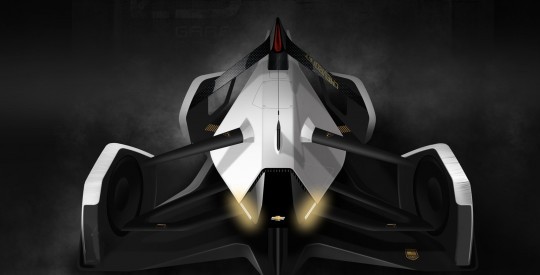Chevrolet Supercars and Hydrogen Power to Drive Around on Future Racetracks
This Chevrolet conceptual design is no different. It is meant to be a visual manifestation of Scott Zhang’s dream, a transportation design student. But unlike most design projects, which are usually driven by a scholarly goal, this one is a personal project. Any time a designer makes a personal project, there are absolutely no restrictions as to who, what, how, where, none of that. So, the result should be one that breaks away from anything we may have seen before.
But that’s a bit hard to do seeing as how the brain hardly manifests something that it hasn’t imagined, seen, or felt before. Nonetheless, it’s still a worthy concept that does include several ideas toward which some sectors of the automotive industry are striving for.
Before we discuss the technology that this vehicle includes in theory, let’s have a look at the body we see. The reason I said the whole bit about the brain not being able to conceptualize anything other than what it has seen so far is because this vehicle, as much as the designer wished to break away from conventional car design, supercars or racers still sport similar body lines.
However, unlike previous concepts we may have seen, the driver pod or cabin is definitely different. Aside from that teardrop shape that screams aerodynamic efficiency, the pod seems to be separated from the rest of the car and is only attached to the chassis via a few support struts similar to those found on Formula cars. Some struts even appear to be used in maneuvering.
Another important aspect of this design is the missing windshield. It’s this particular aspect that initially led us to believe that this is an autonomous design, even though it isn’t. So how the hell do you see where you’re going? Pure and not so simple technology.
Because the driver cannot see where the vehicle is headed, he or she then relies on a number of other systems to relay track info to the eyes and ears. Inside the car, once in your seat, and the casing over your body sealed, a headset is to be utilized in order to see the outside world. But something like this requires a number of sensors and cameras to achieve.
More importantly, other hardware and software needs to be completely failproof. I don’t know about you guys, but being where I am and having so much automotive info on hand, I realize we won’t be there for a while. Which is something the designer seems to have taken into consideration as this Chevy is projected for the year 2050.
But what makes it tick? Well, as most electric cars around, each wheel includes its own motor capable of running independently from all other motors. This is a technological advancement we can find available today in some EVs. But this machine is to be powered through hydrogen energy. However, we know nothing of where this propulsion happens and how it’s to be directed to each individual wheel.
So, for now, this design remains only to please us visually and possibly spark some crazy imagination in someone with more manifestation power ($$) than already established auto giants.
But that’s a bit hard to do seeing as how the brain hardly manifests something that it hasn’t imagined, seen, or felt before. Nonetheless, it’s still a worthy concept that does include several ideas toward which some sectors of the automotive industry are striving for.
Before we discuss the technology that this vehicle includes in theory, let’s have a look at the body we see. The reason I said the whole bit about the brain not being able to conceptualize anything other than what it has seen so far is because this vehicle, as much as the designer wished to break away from conventional car design, supercars or racers still sport similar body lines.
However, unlike previous concepts we may have seen, the driver pod or cabin is definitely different. Aside from that teardrop shape that screams aerodynamic efficiency, the pod seems to be separated from the rest of the car and is only attached to the chassis via a few support struts similar to those found on Formula cars. Some struts even appear to be used in maneuvering.
Another important aspect of this design is the missing windshield. It’s this particular aspect that initially led us to believe that this is an autonomous design, even though it isn’t. So how the hell do you see where you’re going? Pure and not so simple technology.
Because the driver cannot see where the vehicle is headed, he or she then relies on a number of other systems to relay track info to the eyes and ears. Inside the car, once in your seat, and the casing over your body sealed, a headset is to be utilized in order to see the outside world. But something like this requires a number of sensors and cameras to achieve.
More importantly, other hardware and software needs to be completely failproof. I don’t know about you guys, but being where I am and having so much automotive info on hand, I realize we won’t be there for a while. Which is something the designer seems to have taken into consideration as this Chevy is projected for the year 2050.
But what makes it tick? Well, as most electric cars around, each wheel includes its own motor capable of running independently from all other motors. This is a technological advancement we can find available today in some EVs. But this machine is to be powered through hydrogen energy. However, we know nothing of where this propulsion happens and how it’s to be directed to each individual wheel.
So, for now, this design remains only to please us visually and possibly spark some crazy imagination in someone with more manifestation power ($$) than already established auto giants.











No comments:
Post a Comment